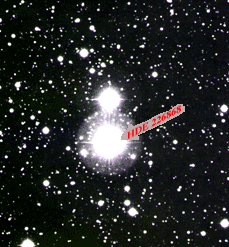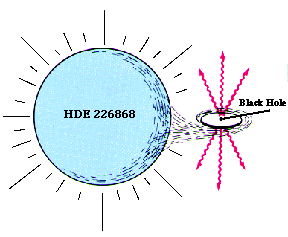Since stellar black holes are small (only a few to a few tens of kilometers in diameter), and light that would allow us to see them cannot escape, a black hole floating alone in space would be hard, if not impossible, to see in the visual spectrum.
However, if a black hole passes through a cloud of interstellar
matter, or is close to another "normal" star, the black hole can
accrete matter into itself. As the matter falls or is pulled towards the black hole, it gains kinetic energy, heats up and is squeezed by tidal forces. The heating
ionizes the atoms, and when the atoms reach a few million
Kelvin, they emit
X-rays. The X-rays are sent off into space before the matter crosses the Schwarzschild radius and crashes into the
singularity. Thus we can see this X-ray emission.
 The optical companion of
The optical companion of
the black hole candidate Cygnus X-1Binary X-ray sources are also places to find strong black hole candidates. A companion star is a perfect source of infalling material for a black hole. A
binary system also allows the calculation of the black hole candidate's mass. Once the mass is found, it can be determined if the candidate is a
neutron star or a black hole, since neutron stars always have masses of about 1.5 times the mass of the Sun. Another sign of the presence of a black hole is its random variation of emitted X-rays. The infalling matter that emits X-rays does not fall into the black hole at a steady rate, but rather more sporadically, which causes an observable variation in X-ray intensity. Additionally, if the X-ray source is in a binary system, and we see it from certain angles, the X-rays will be periodically cut off as the source is
eclipsed by the companion star. When looking for black hole candidates, all these things are taken into account. Many X-ray
satellites have scanned the skies for X-ray sources that might be black hole candidates.
Cygnus X-1 (Cyg X-1) is the longest known of the black hole candidates. It is a highly variable and irregular source, with X-ray emission that flickers in hundredths of a second. An object cannot flicker faster than the time required for light to travel across the object. In a hundredth of a
second, light travels 3,000 kilometers. This is one fourth of Earth's diameter. So the region emitting the X-rays around Cyg X-1 is rather small. Its companion star, HDE 226868 is a B0 supergiant with a surface temperature of about 31,000 K.
Spectroscopicobservations show that the
spectral lines of HDE 226868 oscillate with a period of 5.6 days. From the mass-
luminosity relation, the mass of this supergiant is calculated as 30 times the mass of the Sun. Cyg X-1 must have a mass of about 7
solar masses, or it would not exert enough gravitational pull to cause the wobble in the spectral lines of HDE 226868. Other estimate put the mass of Cyg X-1 to as much as 16 solar masses. Since 7 solar masses is too large to be a
white dwarf or neutron star, it must be a black hole.
 |
An illustration of Cygnus X-1, showing the companion star HDE 226868,
the black hole, material streaming from the companion to the black hole,
and the emission of X-rays near the black hole. |
There are now about 20 X-ray binaries (as of early 2009) with known black holes (from measurements of the black hole mass). The first of these, an X-ray transient called A0620-00, was discovered in 1975, and the mass of the compact object was determined in the mid-1980's to be greater than 3.5 solar masses. This very clearly excludes a neutron star, which has a mass near 1.5 solar masses, even allowing for all known theoretical uncertainties. The best case for a black hole is probably V404 Cygni, whose compact star is at least 10 solar masses. There are an additional 20 X-ray binaries which are likely to contain black holes - their behavior is the same as the confirmed black holes, but mass measurements have not been possible.
Last Modified: December 2010


